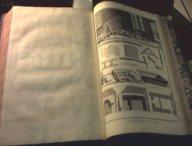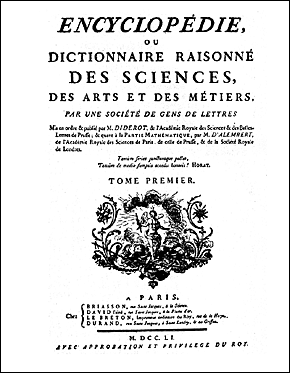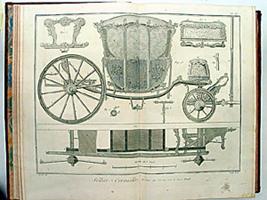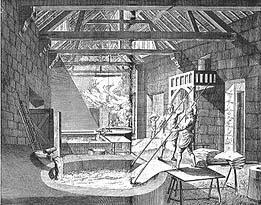The Encyclopédie, ou Dictionnaire Raisonné des Sciences, des Arts et des Métiers
(Encyclopaedia, or Classified Dictionary of Sciences, Arts and Trades)
 Published under the general editorship of the philosopher Denis Diderot with the assistance of the mathematician Jean Le Rond d'Alembert, the Encyclopédie was designed as a medium for radical and revolutionary ideas. Its general plan was announced through a Discours préliminaire in 1751, and the first volume appeared in the same year.
Published under the general editorship of the philosopher Denis Diderot with the assistance of the mathematician Jean Le Rond d'Alembert, the Encyclopédie was designed as a medium for radical and revolutionary ideas. Its general plan was announced through a Discours préliminaire in 1751, and the first volume appeared in the same year.
In 1758, after publication of the seventh volume, d'Alembert resigned as editor, having received warning of troubles ahead and following an attack of his contributed article Genève by Rousseau. (Geneva was a centre of Calvinism at the time, and an article on the city inevitably was of religious relevance.)
Soon after the Parliament of Paris ordered the book De l'esprit ("On the Mind") of the philosopher Helvétius to be burned. Helvétius' book was widely believed to be a summary of the Encyclopédie, and the entire project was formally banned in 1759.
The difficulties attracted great minds to the project, which up to that point had been driven by Diderot and his group of previously unknown contributors. Voltaire, Rousseau and others joined the team. Voltaire suggested to shift the publication to a city outside France, but Diderot refused and continued to publish, beginning with the uncontroversial volumes of plates and then publishing the text volumes surreptitiously. He was outraged and deeply offended when he discovered in 1764 that the publisher had removed some 300 pages of dangerous material from the proofs without his knowledge or authorization.
The first edition was completed in 1772 and consisted of 17 volumes of text and 11 volumes of plates. Diderot supervised the production of the more than 3,000 plates himself, and their quality is still prized today. Four more volumes of text and another volume of plates followed as a supplement in 1776 - 1777, and in 1780 an index in two volumes was added.
Work on a second edition began in 1782, based on a systematic classification rather than the original alphabetical arrangement. Work on the edition continued through the French Revolution and was completed in 1832 with the publication of the final 166th volume.
Reference
Niklaus, R. (1995) Denis Diderot. Encyclopaedia Britannica 15th ed.
Illustration: check the copyright status.

The title page of the first volume of the first edition, 1751
Illustration: public domain

Illustration to practices in ocean fisheries
Illustration: public domain

Illustration to show the techniques for making fishing nets
Illustration: public domain

Illustration to show details of coach construction, including a modern suspension system
Illustration: public domain

Illustration of industrial factory processes
Illustration: public domain
home
 Published under the general editorship of the philosopher Denis Diderot with the assistance of the mathematician Jean Le Rond d'Alembert, the Encyclopédie was designed as a medium for radical and revolutionary ideas. Its general plan was announced through a Discours préliminaire in 1751, and the first volume appeared in the same year.
Published under the general editorship of the philosopher Denis Diderot with the assistance of the mathematician Jean Le Rond d'Alembert, the Encyclopédie was designed as a medium for radical and revolutionary ideas. Its general plan was announced through a Discours préliminaire in 1751, and the first volume appeared in the same year.



